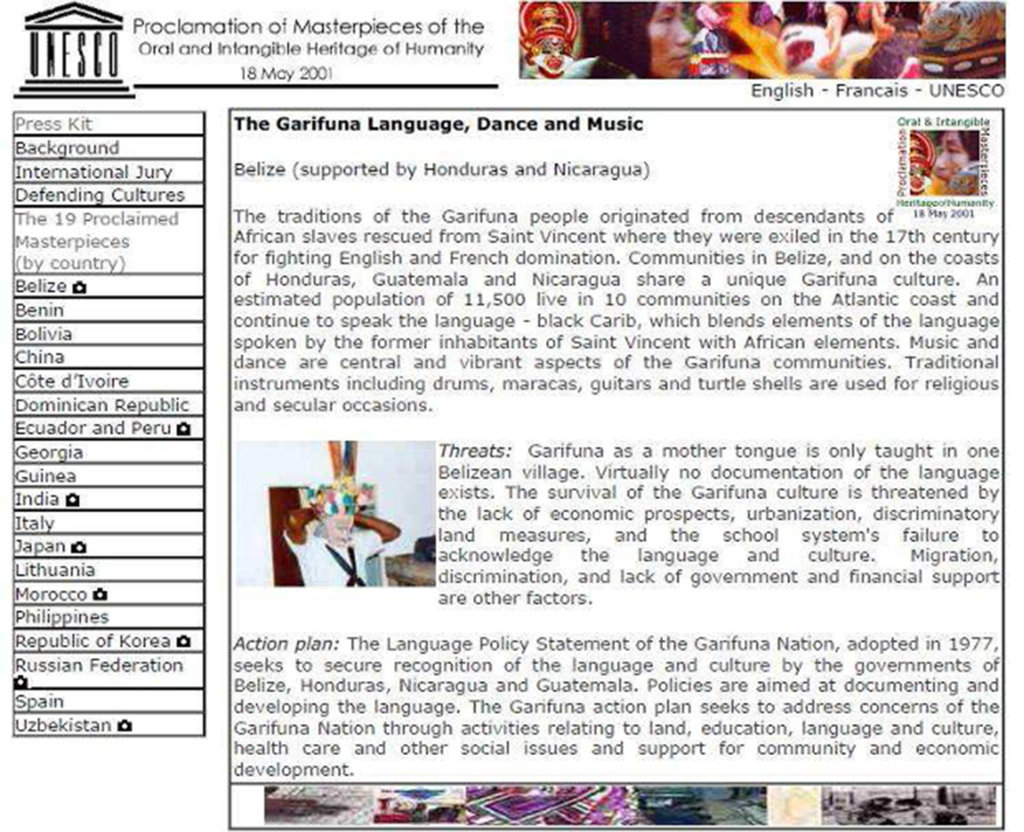
On May 18th, 2001, the United Nations Educational, Scientific and Cultural Organization (UNESCO) for the first time awarded the title of “Masterpiece of the Oral and Intangibles Heritage of Humanity,” to nineteen outstanding cultural spaces of forms of expression from different regions of the world. The Garifuna Language, Dance and Music of Belize were among those cultural spaces.
Recognizing the cultural threat, in 2001 UNESCO proclaimed the Garifuna language, dance, and music to be among the “Masterpieces of the Oral and Intangible Heritage of Humanity”. Acknowledging a heritage worthy of recognition and cultural protection, UNESCO’s intervention has reinforced local efforts to promote Garifuna expressive culture, bringing renewed dedication to teaching the Garifuna language, dance, and music, particularly targeting young Garinagu at home and abroad. (Cayetano and Cayetano 2005)
The safeguarding project focuses on the preservation of the Garifuna language through language revitalization, lexical expansion programs and the promotion of teaching, learning, and practicing. It will also develop an inventory of Garifuna art forms (such as songs, music, dances, and related customs.) and promote regional Garifuna festivals with a view to confronting the erosion of the Garifuna culture in the heart of modern-day communities. As a general objective, the project seeks to strengthen the capacities of the Garifuna communities to promote the safeguarding of its heritage.
Safeguarding a Living Heritage
Just like culture in general, intangible heritage is constantly changing and evolving, and being enriched by each new generation. Many expressions and manifestations of intangible cultural heritage are under threat, endangered by globalization and cultural homogenization, and by a lack of support, appreciation and understanding. If intangible cultural heritage is not nurtured, it risks becoming lost forever, or frozen as a practice belonging to the past. Preserving this heritage and passing it on to future generations strengthens it and keeps it alive while allowing for it to change and adapt.
For intangible heritage to be kept alive, it must remain relevant to a culture and be regularly practiced and learned within communities and between generations.
Communities and groups who practice these traditions and customs everywhere in the world have their own systems for transmitting their knowledge and skills, usually dependent on word of mouth rather than written texts. Safeguarding activities must therefore always involve the communities, groups and, where appropriate, individuals that bear such heritage.
There is a risk that certain elements of intangible cultural heritage could die out or disappear without help, but how can we safeguard and manage a heritage that is constantly changing and part of ‘living culture’ without freezing or trivializing it? Safeguarding them is about the transferring of knowledge, skills and meaning. In other words, safeguarding focuses on the processes involved in transmitting, or communicating intangible cultural heritage from generation to generation, rather than on the production of its concrete manifestations, such as a dance performance, a song, a music instrument, or a craft.
Safeguarding means making sure that intangible cultural heritage remains an active part of life for today’s generations that they can hand on to tomorrows. Safeguarding measures aim at ensuring its viability, its continuous recreation, and its transmission. Initiatives for safeguarding intangible cultural heritage might include identifying and documenting such heritage, research, preservation, promotion, enhancement, or transmission of it – particularly through formal and non-formal education – as well as revitalizing various aspects of it.